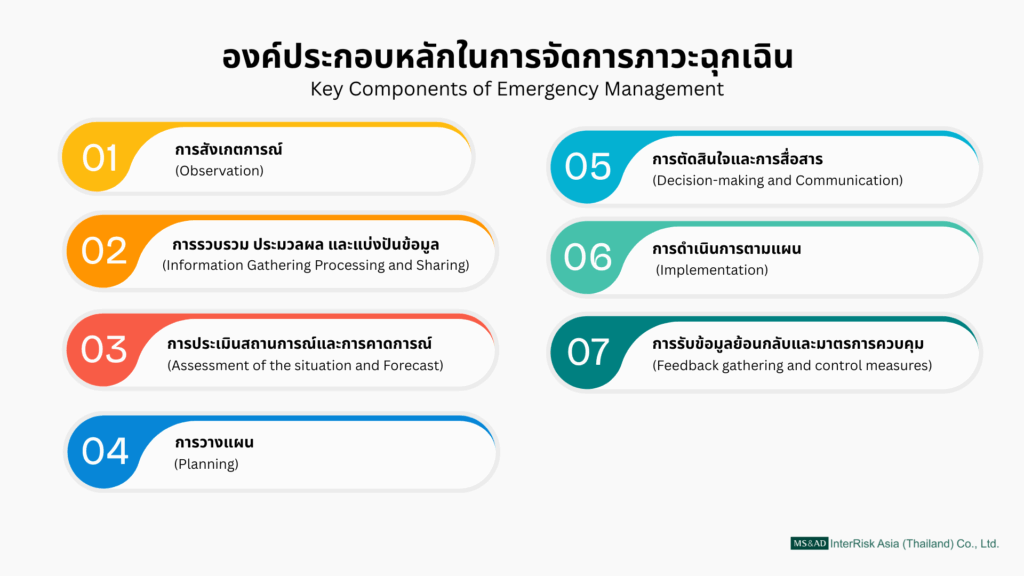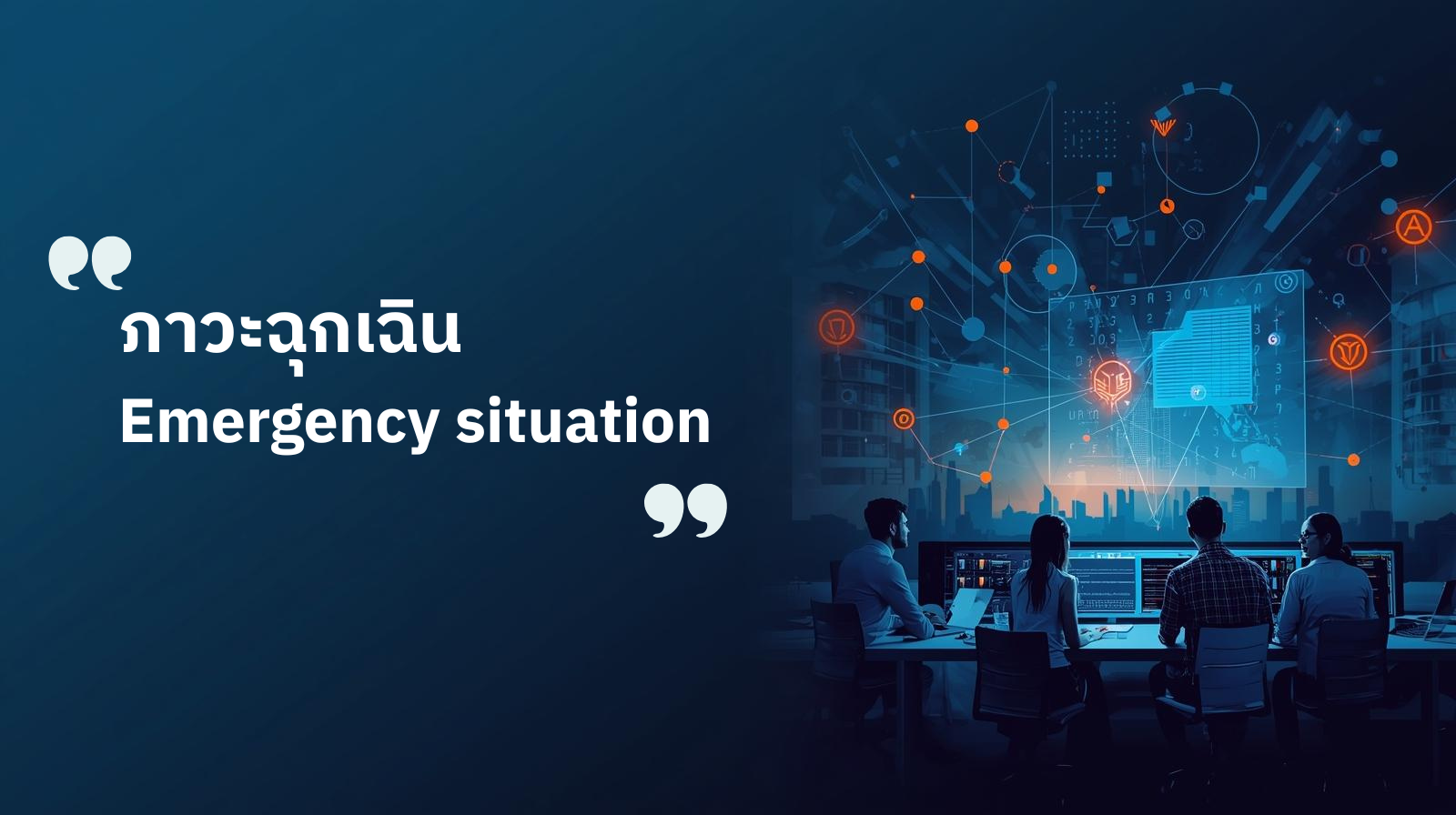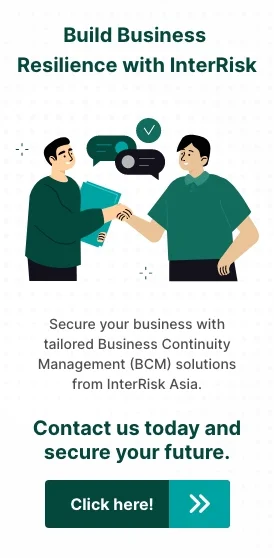Emergencies become unavoidable challenges when unexpected events occur.
Understanding what constitutes an emergency and recognizing its different levels enables effective preparedness and response planning. Whether throughRisk assessment orthe development of emergency plans, having a clear and structured approach—along with training personnel to act appropriately during emergencies—is essential for minimizing damage and restoring operations as quickly as possible.
HIGHLIGHTS:
- An emergency is an unforeseen event that impacts lives, property, and organizational operations. It is essential to have a clear emergency plan in place to respond effectively.
- Objectives of an emergency plan: minimize damage, ensure continuity, build confidence, and enable safe, systematic decision-making in times of crisis.
- An emergency plan should cover multiple scenarios such as fire, flood, pandemic, power outage, and cyber threats, in order to minimize impacts and enable rapid recovery.
- In general, emergency situations are classified into four levels: minor, moderate, severe, and critical. The management of such emergencies can be guided by ISO 22320 standards, which help organizations develop appropriate response plans.
What is a crisis? Why do businesses need a contingency plan?
A crisis is an unexpected situation that affects an organization’s operations, safety, or assets. Whether it is a natural disaster, an accident, a disease outbreak, or a cyber incident, all are considered emergencies that may disrupt business or cause severe damage.
Developing an emergency plan helps reduce the impact on a business in terms of finances, credibility, and employee safety In addition, it is part of the principles of emergency management that organizations should regularly practice and continuously improve to ensure preparedness when a real crisis occurs. Whether it is an emergency in a factory orcyber attack affecting core business systems, such planning is essential.
In today’s world, where risks can arise on a daily basis, having a clear emergency plan is not an option but a necessity. This is especially true in high‑risk industries such as manufacturing, energy, or healthcare. Understanding what constitutes an emergency enables businesses to establish systematic response strategies.

Levels of emergency situations
ภาวะฉุกเฉิน สามารถแบ่งออกเป็นหลายระดับตามความรุนแรงและผลกระทบที่เกิดขึ้นต่อบุคคล ทรัพย์สิน หรือการดำเนินงานขององค์กร โดยการแบ่งระดับนี้อ้างอิงจากมาตรฐานด้านความปลอดภัย เช่น ISO 22320 Emergency Management, มาตรฐานการจัดการเหตุฉุกเฉินของสากล และแนวทางของหน่วยงานภาครัฐ
- Level 1: Minor Emergency An incident that can be controlled within the organization, such as a temporary power outage or minor equipment malfunction, without affecting overall safety.
- Level 2: Moderate Emergency An incident that begins to affect operations, such as a network outage or a workplace accident, requires internal coordination and the initiation of the emergency plan.
- Level 3: Major Emergency An incident that impacts lives and property, such as a fire emergency, an earthquake, or a disease outbreak, requires evacuation or partial suspension of operations.
- Level 4: Crisis Level Emergency An incident with widespread impact, such as a nationwide disaster, a cyberattack, or the collapse of critical infrastructure, must be managed under the principles of emergency management and may require external support.
Example of Crisis that could be happen
Emergencies can arise from various causes, including natural disasters, system failures, or human‑made threats. Preparing a comprehensive emergency plan that covers different scenarios is therefore essential for organizations seeking to minimize damage and restore operations quickly.
Covering evacuation, basic firefighting, and coordination with external agencies to prevent loss of life and property.
Preparing safe areas, protecting assets, and carrying out post‑flood recovery to enable the fastest possible resumption of operations.
Preventing IT system attacks, such as data hacking or computer viruses, which may affect data security and business operations.
Preparing backup power systems and operational procedures in the event of an incident to ensure that the production process is not disrupted.
Such as COVID‑19 or other infectious diseases that affect employee health and the supply of medical equipment.
Establish guidelines for evacuation, building structure inspection, and the safe care of affected individuals.
What are components of Crisis management
Emergency management is based on comprehensive planning that encompasses the pre-incident, incident, and post-incident phases, with the aim of mitigating impacts and ensuring the effective recovery of the organization.
The main components of emergency management, according to ISO 22320 Emergency Management, include:

Ongoing monitoring and assessment to ensure early detection of potential emergency indicators.
Coordinated data management from diverse sources to provide stakeholders with accurate, timely, and actionable information for effective decision-making.
Conduct impact analysis of potential emergency events and forecast emerging trends to develop effective contingency plans.
Establish response and emergency management guidelines, including prioritization, resource allocation, and personnel preparedness.
Timely and precise decision-making, supported by clear communication across all stakeholders, to ensure coordinated and consistent execution.
Implement the established plan through coordination among teams and relevant agencies to effectively control the situation.
Review operational outcomes, evaluate the effectiveness of the plan, and adjust measures to suit changing circumstances.
Objective of having an emergency response plan
When unexpected events occur, the speed of response determines whether an organization will survive or be disrupted — this is a key reason why having an emergency response plan is essential.
Key objectives of establishing an emergency response plan are as follows:
To prevent potential harm to personnel, customers, and organizational assets during emergencies.
Enable the organization to continue core operations even during emergency situations.
Build trust among customers, employees, and investors that the organization is well-prepared to handle unexpected situations.
A well-defined plan enables rapid and effective post-incident recovery.
Provide clear guidelines for decision-making and action during times that require speed and precision.
Such as ISO 22320 and emergency management guidelines that organizations should follow to ensure safety and social responsibility.
Steps for responding to potential emergencies
In the event of an emergency whether caused by natural disasters, accidents, or incidents affecting organizational operations—response efforts must be systematic, swift, and effective, based on the international standard ISO 22320:2018 – Emergency Management, which clearly outlines the structure for managing emergency situations.
Key components of the emergency response structure according to ISO 22320:
Establish decision-making authority, design an incident management structure, and allocate resources systematically to effectively control the situation.
Collect, assess, and share incident information in a timely manner, while developing a clear action plan, including status reporting and personnel allocation.
Carry out strategic objectives such as risk reduction, protection of life and property, and control of the situation leading to the recovery phase.
Manage facilities, equipment, transportation, fuel, food, and medical services, including support for information and communication technology.
Oversee disbursement, procurement, compensation, and the management of time and cost, which may be handled by a dedicated unit or integrated into the main structure depending on the scale of the incident.
Free Download Basic Emergency Management Principles Manual from InterRisk
InterRisk Asia has developed a free downloadable PDF manual outlining the basic principles of emergency management to support systematic preparedness.
Who is this intended for?
- Safety Officer
- Risk Management
- Government agencies and private organizations seeking to plan for emergency preparedness.
Frequently Asked Questions (FAQs)
Should organizations have an emergency response plan?
Organizations should have an emergency response plan to enable rapid action, minimize impact, and efficiently restore operations.
Who is responsible in the event of an emergency?
An Emergency Response Team should be appointed, with clearly defined roles and responsibilities.
How should communication with employees and stakeholders be handled during a crisis?
Clear communication channels must be established, such as phone, email, internal apps, or website announcements, to deliver accurate and timely information.
What should be done after an emergency?
A post-incident review, lessons learned summary, and plan improvement should be conducted to prevent recurrence in the future.
Emergency Management with InterRisk Asia
Having a clear and systematic emergency plan is essential to enable rapid response and minimize potential damage.
InterRisk offers comprehensive services ranging from risk assessment, BCP planning, BCP training, and BCP drills to end-to-end consulting, delivered by a team of experienced professionals. InterRisk is also a leading business continuity management consultant in Thailand, operating under the MS&AD Group from Japan.
End-to-end consulting for the development of a robust BCMS, with pathways to ISO 22301 certification
Specialized training programs designed for both management and staff to enhance awareness and competency in BCMS practices.
Analysis of operational risks and disruption impacts to inform the development of targeted continuity strategies.
Structured exercises to validate your BCP and strengthen organizational preparedness and response capabilities.
Experienced consultants with hands-on BCMS expertise
Customized planning tailored to your business context.
Practical tools and templates, with expert support for testing and improvement.

